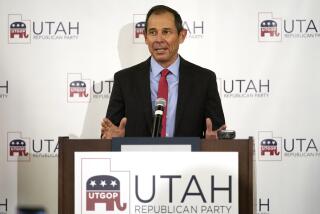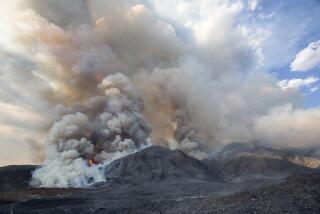Op-Ed: Reagan made a massive environmental mistake. Trump is repeating it, only worse
President Trump’s exquisitely awful decision to pull the U.S. out of the Paris climate accords has been underscored by the National Oceanic and Atmospheric Administration’s announcement that 2017 was the second-warmest year ever recorded. To understand the true costs of the United States’ abnegation of its international responsibilities, there’s a useful analog in the story of another global environmental threat that arose in the last century. Then, too, the world was moving toward a united response when a U.S. presidential election intervened. Ultimately, the world dodged a bullet. This time, we may not be so lucky.
In 1974, the world was facing the depletion of the ozone layer. The distinguished science journal Nature had published an article providing evidence that chlorine compounds called CFCs were migrating to the upper atmosphere and destroying the ozone molecules that formed a protective shield against harmful ultraviolet radiation (three scientists — Sherwood Rowland, Mario Molina and Paul Crutzen — were later awarded the Nobel Prize in chemistry for the discovery). Without the shield, UV radiation would reach the Earth’s surface, causing an extraordinary range of harmful effects, including cancers in animals and people and the wholesale destruction of phytoplankton, the basis of the oceanic food chain. By the late 1970s, the Carter administration had banned the use of CFCs in aerosol sprays, and was moving to phase out their use in refrigeration. Then came the election of Ronald Reagan.
CFC-using industries were already challenging the science and fighting regulation. They lobbied Congress, arguing that eliminating CFCs would cost tens of thousands of jobs. If this sounds a lot like the fossil fuel industry’s posture toward global warming, it should: The playbook developed to slow efforts to combat climate change was developed during the CFC battle. Indeed, a number of the same scientists who disputed ozone depletion later showed up before Congress casting doubt on climate change. In the ’70s, they discovered they didn’t need to refute the science to delay action, they only needed to convince the public it was not yet settled.
Before Reagan, CFC producers were preparing for a worldwide ban on the compounds. DuPont, the dominant manufacturer, had begun to develop an alternative refrigerant. After the 1980 election, however, industry lobbyists found a friendly audience for their arguments. Anne Burford, Reagan’s Environmental Protection Agency chief (and mother of Supreme Court Justice Neil M. Gorsuch), dismissed the threat of CFCs as an “unsubstantiated scare story.” DuPont halted work on the alternatives, and production of CFCs reached new highs.
Then the world got lucky. In 1982, Joe Farman, a British geophysicist doing research in Antarctica, noticed something odd about the data he was collecting on stratospheric ozone. The readings, which had been stable for 25 years, began to show a drop. At first, he thought it was instrument error, but a recheck validated the measurements. Farman doggedly pursued the data, and in 1985 the world learned about the “ozone hole.”
The rapid expansion of the ozone hole put the lie to the industry-sponsored disinformation campaign. In 1986, DuPont dropped its opposition to a CFC phase-out, but this seemingly high-minded action should be considered in context. DuPont had the lead in getting alternatives to market, and those alternatives promised bigger profit margins than CFCs. In September 1987, the Montreal Protocol was signed; 197 nations agreed to its terms, making it the first universally ratified treaty in the history of the United Nations.
Despite the dire warnings of industry, the transition away from CFCs didn’t interrupt economic growth any more than had the earlier 20th century disappearance of the buggy whip. The important consequences of the delay in the phase-out were borne by Planet Earth.
The rapid expansion of the ozone hole put the lie to the industry-sponsored disinformation campaign.
Between 1978, when the Carter administration was moving toward phase-out, and 1988, just before the Montreal Protocol went into force, some 19 billion pounds of CFCs were produced. Like carbon dioxide molecules, CFCs have a life in the atmosphere that is measured in decades, and so for years after the treaty was ratified the ozone hole continued to grow. It was only in 2017, nearly 30 years after the protocol’s signing, that scientists detected that the ozone hole was beginning to shrink. Sometime after 2050, they estimate, the ozone layer will return to normal.
We don’t know how much smaller the ozone hole would have been had the world banned CFCs in 1978. But we do know that without Joe Farman, we might not have discovered this smoking gun until much later, perhaps too late for humanity and the biosphere.
Is there something similar that will put the lie to the disinformation campaign still being waged against the consensus on global warming? Perhaps the biblical hurricanes of last summer will shake the confidence of the deniers. Or more likely, the ubiquitous and unambiguous signal of costly, catastrophic sea-level rise.
Unfortunately, we need a Joe Farman (or two or three) to document the situation. The Trump administration wants to cut the budgets of the programs that monitor the atmosphere, and it’s opposed to the Federal Emergency Management Agency updating flood maps to take into account the danger of rising seas.
Still, there is one more analogy between the ozone story and global warming that offers a glimmer of hope. As the Trump administration and Congress feverishly try to build a bridge to the 19th century, industry and many state and local governments are looking forward. General Motors and Ford are greatly expanding their production of electric cars. China, India, Britain and France, as well as California and other states, are considering bans on fossil-fuel vehicles. As did DuPont in the 1980s, these carmakers and other industries now recognize that remaining competitive requires them to adapt to the scientific consensus on climate change. We can only hope that it’s not too late.
Eugene Linden is the author of “Winds of Change: Climate, Weather, and the Destruction of Civilizations.”
Follow the Opinion section on Twitter @latimesopinionand Facebook
More to Read
A cure for the common opinion
Get thought-provoking perspectives with our weekly newsletter.
You may occasionally receive promotional content from the Los Angeles Times.






